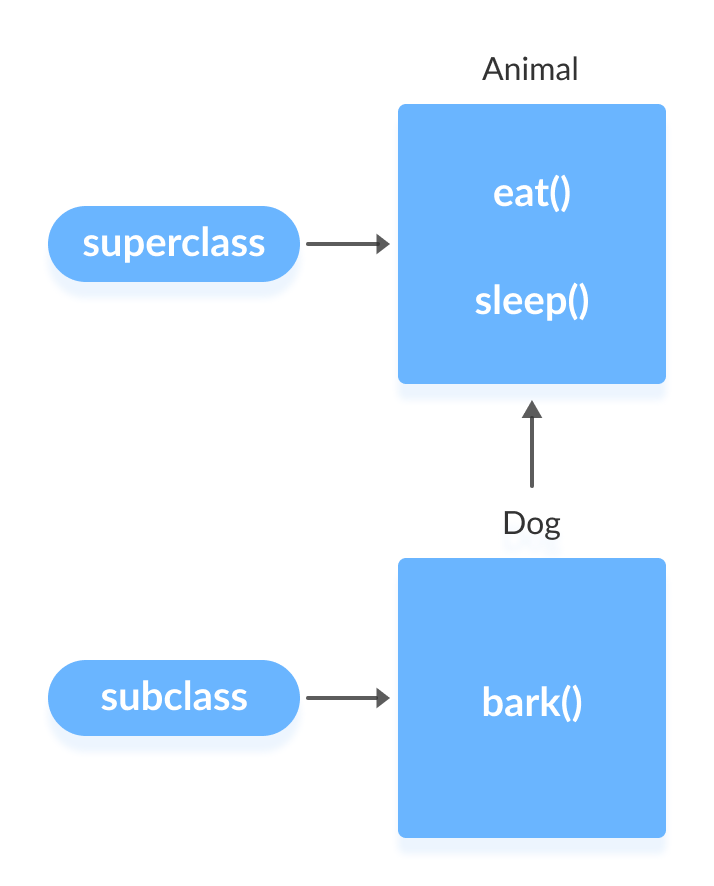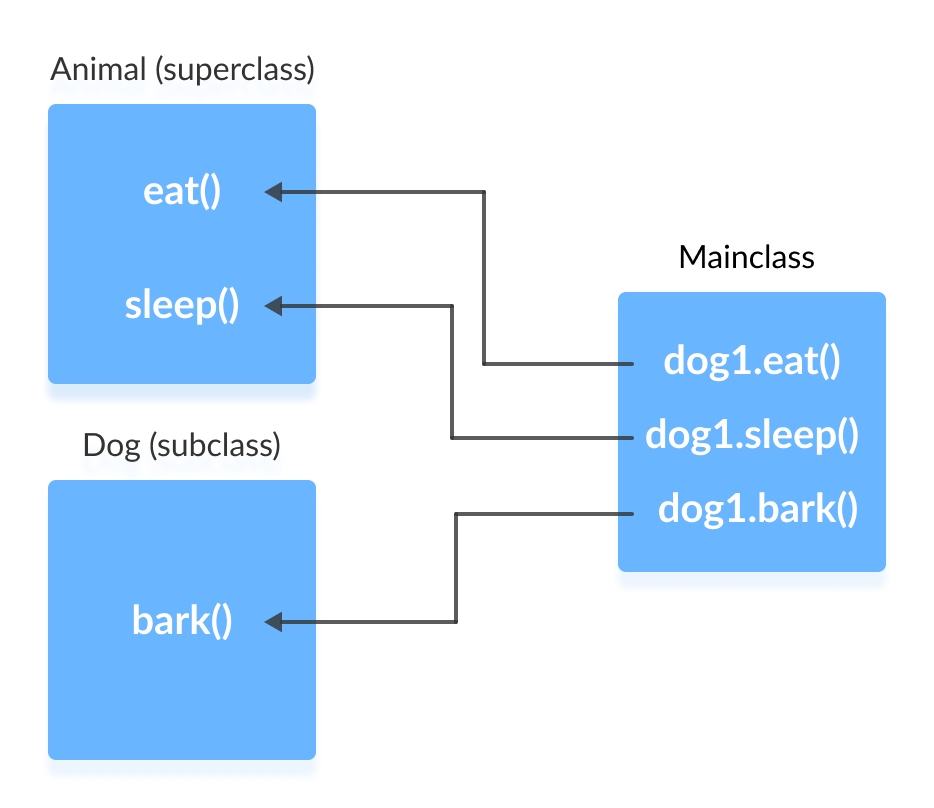(Java programming Example for Beginners)
Java Inheritance
In this tutorial, we will learn about inheritance in Java with the help of examples.
Inheritance is one of the key features of OOP (Object-oriented Programming) that allows us to define a new class from an existing class. For example,
class Animal{
// eat() method
// sleep() method
}
class Dog extends Animal{
// bark() method
}
In Java, we use the extends keyword to inherit from a class. Here, we have inherited the Dog class from the Animal class.
The Animal is the superclass (parent class or base class), and the Dog is a subclass (child class or derived class). The subclass inherits the fields and methods of the superclass.

is-a relationship
Inheritance is an is-a relationship. We use inheritance only if an is-a relationship is present between the two classes.
Here are some examples:
- A car is a vehicle.
- Orange is a fruit.
- A surgeon is a doctor.
- A dog is an animal.
Example 1: Java Inheritance
class Animal{
public void eat(){
System.out.println("I can eat");
}
public void sleep(){
System.out.println("I can sleep");
}
}
class Dog extends Animal{
public void bark(){
System.out.println("I can bark");
}
}
class Main{
public static void main(String[] args){
Dog dog1 = new Dog();
dog1.eat();
dog1.sleep();
dog1.bark();
}
}
Output
I can eat I can sleep I can bark
Here, we have inherited a subclass Dog from superclass Animal. The Dog class inherits the methods eat() and sleep() from the Animal class.
Hence, objects of the Dog class can access the members of both the Dog class and the Animal class.

protected Keyword
We learned about private and public access modifiers in previous tutorials.
privatemembers can be accessed only within the classpublicmembers can be accessed from anywhere
You can also assign methods and fields protected. Protected members are accessible
- from within the class
- within its subclasses
- within the same package
Here’s a summary from where access modifiers can be accessed.
| Class | Package | subclass | World | |
|---|---|---|---|---|
| public | Yes | Yes | Yes | Yes |
| private | Yes | No | No | No |
| protected | Yes | Yes | Yes | No |
Example 2: protected Keyword
class Animal{
protected String type;
private String color;
public void eat(){
System.out.println("I can eat");
}
public void sleep(){
System.out.println("I can sleep");
}
public String getColor(){
return color;
}
public void setColor(String col){
color = col;
}
}
class Dog extends Animal{
public void displayInfo(String c){
System.out.println("I am a " + type);
System.out.println("My color is " + c);
}
public void bark(){
System.out.println("I can bark");
}
}
class Main{
public static void main(String[] args){
Dog dog1 = new Dog();
dog1.eat();
dog1.sleep();
dog1.bark();
dog1.type = "mammal";
dog1.setColor("black");
dog1.displayInfo(dog1.getColor());
}
}
Output
I can eat I can sleep I can bark I am a mammal My color is black
Here, the type field inside the Animal class is protected. We have accessed this field from the Main class using
dog1.type = "mammal";It is possible because both the Animal and Main classes are in the same package (same file).
Java Method overriding
From the above examples, we know that objects of a subclass can also access methods of its superclass.
What happens if the same method is defined in both the superclass and subclass?
Well, in that case, the method in the subclass overrides the method in the superclass. For example,
Example 3: Method overriding Example
class Animal{
protected String type = "animal";
public void eat(){
System.out.println("I can eat");
}
public void sleep(){
System.out.println("I can sleep");
}
}
class Dog extends Animal{
@Override
public void eat(){
System.out.println("I eat dog food");
}
public void bark(){
System.out.println("I can bark");
}
}
class Main{
public static void main(String[] args){
Dog dog1 = new Dog();
dog1.eat();
dog1.sleep();
dog1.bark();
}
}
Output
I eat dog food I can sleep I can bark
Here, eat() is present in both the superclass Animal and subclass Dog. We created an object dog1 of the subclass Dog.
When we call eat() using the dog1 object, the method inside the Dog is called, and the same method of the superclass is not called. This is called method overriding.
In the above program, we have used the @Overrideannotation to tell the compiler that we are overriding a method. However, it’s not mandatory. We will learn about method overriding in detail in the next tutorial.
If we need to call the eat() method of Animal from its subclasses, we use the super keyword.
Example 4: super Keyword
class Animal{
public Animal(){
System.out.println("I am an Animal");
}
public void eat(){
System.out.println("I can eat");
}
}
class Dog extends Animal{
public Dog(){
super();
System.out.println("I am a dog");
}
@Override
public void eat(){
super.eat();
System.out.println("I eat dog food");
}
public void bark(){
System.out.println("I can bark");
}
}
class Main{
public static void main(String[] args){
Dog dog1 = new Dog();
dog1.eat();
dog1.bark();
}
}
Output
I am an Animal I am a dog I can eat I eat dog food I can bark
Here, we have used the super keyword to call the constructor using super(). Also, we have called the eat() method of Animal superclass using super.eat().
Note the difference in the use of super while calling constructor and method.
Types of inheritance
There are five types of inheritance.
- Single inheritance – Class B extends from class A only.
- Multilevel inheritance – Class B extends from class A; then class C extends from class B.
- Hierarchical inheritance – Class A acts as the superclass for classes B, C, and D.
- Multiple inheritance – Class C extends from interfaces A and B.
- Hybrid inheritance – Mix of two or more types of inheritance.
Java doesn’t support multiple and hybrid inheritance through classes. However, we can achieve multiple inheritance in Java through interfaces. We will learn about interfaces in later chapters.
Why use inheritance?
- The most important use is the reusability of code. The code that is present in the parent class doesn’t need to be written again in the child class.
- To achieve runtime polymorphism through method overriding. We will learn more about polymorphism in later chapters.
Java tutorials for Beginners – Java Inheritance
Disclaimer: The information and code presented within this recipe/tutorial is only for educational and coaching purposes for beginners and developers. Anyone can practice and apply the recipe/tutorial presented here, but the reader is taking full responsibility for his/her actions. The author (content curator) of this recipe (code / program) has made every effort to ensure the accuracy of the information was correct at time of publication. The author (content curator) does not assume and hereby disclaims any liability to any party for any loss, damage, or disruption caused by errors or omissions, whether such errors or omissions result from accident, negligence, or any other cause. The information presented here could also be found in public knowledge domains.
